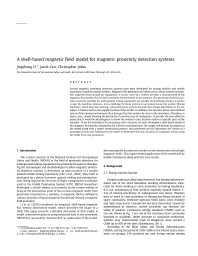Mining Publication: A Shell-Based Magnetic Field Model for Magnetic Proximity Detection Systems
Original creation date: March 2012
Several magnetic proximity detection systems have been developed for mining vehicles and mobile machinery to protect nearby workers. Magnetic field generators are often used in these systems to establish magnetic fields around the equipment. A sensor worn by a worker provides a measurement of the magnetic flux density that is used to estimate the proximity to the machine. The proximity detection systems currently available for underground mining equipment are capable of identifying whether a worker is near the machine. However, it is a challenge for these systems to accurately locate the worker. Mining machines, which have fast-moving, articulated parts, present hazards that change depending on the situation at hand as well as the specific location of the worker. In addition, the dynamic nature and confined spaces of the mining environment often demand that the workers be close to the machinery. Therefore, in many cases, simply knowing the proximity of a worker may be inadequate. To provide the most effective protection, it would be advantageous to know the worker’s exact location relative to specific parts of the machine. To lay the foundation for measuring such a location, we have developed a shell-based model of the magnetic flux density distribution for a ferrite-cored generator. This paper will present an analysis of the model along with a model construction process. Also presented are the laboratory test results of a prototype system that implements this model to determine the exact location of a magnetic sensor using the fields from two generators.
Authors: J Li, JL Carr, CC Jobes
See Also
- CFD Modeling of Fire Spread Along Combustibles in a Mine Entry
- Engineering Considerations and Selection Criteria for Proximity Warning Systems for Mining Operations
- Evaluation of the Relative Importance of Coalbed Reservoir Parameters for Prediction of Methane Inflow Rates During Mining of Longwall Development Entries
- Experimental and Modeling Investigation of the Effect of Ventilation on Smoke Rollback in a Mine Entry
- MCP - Methane Control and Prediction - 2.0
- Modeling and Data Analysis of 50 to 5000 kHz Radio Wave Propagation in Coal Mines
- Recommendations for Evaluating & Implementing Proximity Warning Systems on Surface Mining Equipment
- Reservoir Engineering Considerations for Coal Seam Degasification and Methane Control in Underground Mines
- Test Results of Collision Warning Systems for Surface Mining Dump Trucks
- Variation of Horizontal Stresses and Strains in Mines in Bedded Deposits in the Eastern and Midwestern United States
- Content source: National Institute for Occupational Safety and Health, Mining Program


 ShareCompartir
ShareCompartir
